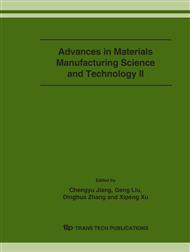p.845
p.849
p.853
p.857
p.861
p.865
p.869
p.873
p.877
Application of Abductive Network and FEM to Predict the Maximum Forging Force and the Final Face Width of Spur Gear
Abstract:
The process of precision gear forging has been developed recently because of its advantages of giving high production rates and improved strength. For complete filling up, predicting the power requirement and final face width is an important feature of the forging process. A finite element analysis is utilized to investigate the maximum forging force and final face width under different process parameters such as modules, number of teeth, and the ratio of the height to diameter of billet. The abductive network is then applied to synthesize the data sets obtained from the numerical simulation, and a prediction model is established ultimately. Employing the predictive model can provide valuable references in prediction of the forging force and final face width under a suitable range of process parameters.
Info:
Periodical:
Pages:
861-864
Citation:
Online since:
December 2006
Authors:
Keywords:
Price:
Сopyright:
© 2006 Trans Tech Publications Ltd. All Rights Reserved
Share:
Citation:


